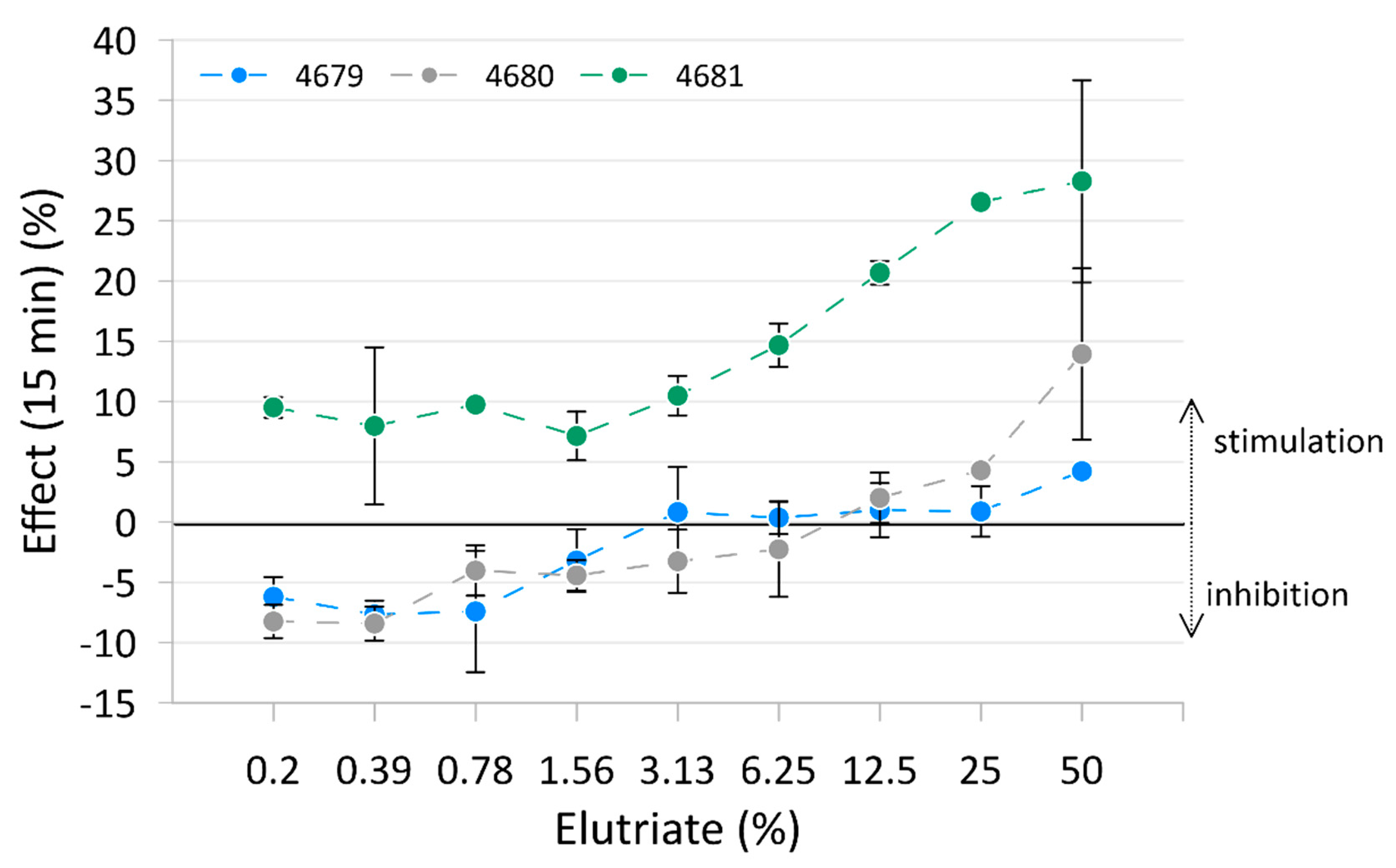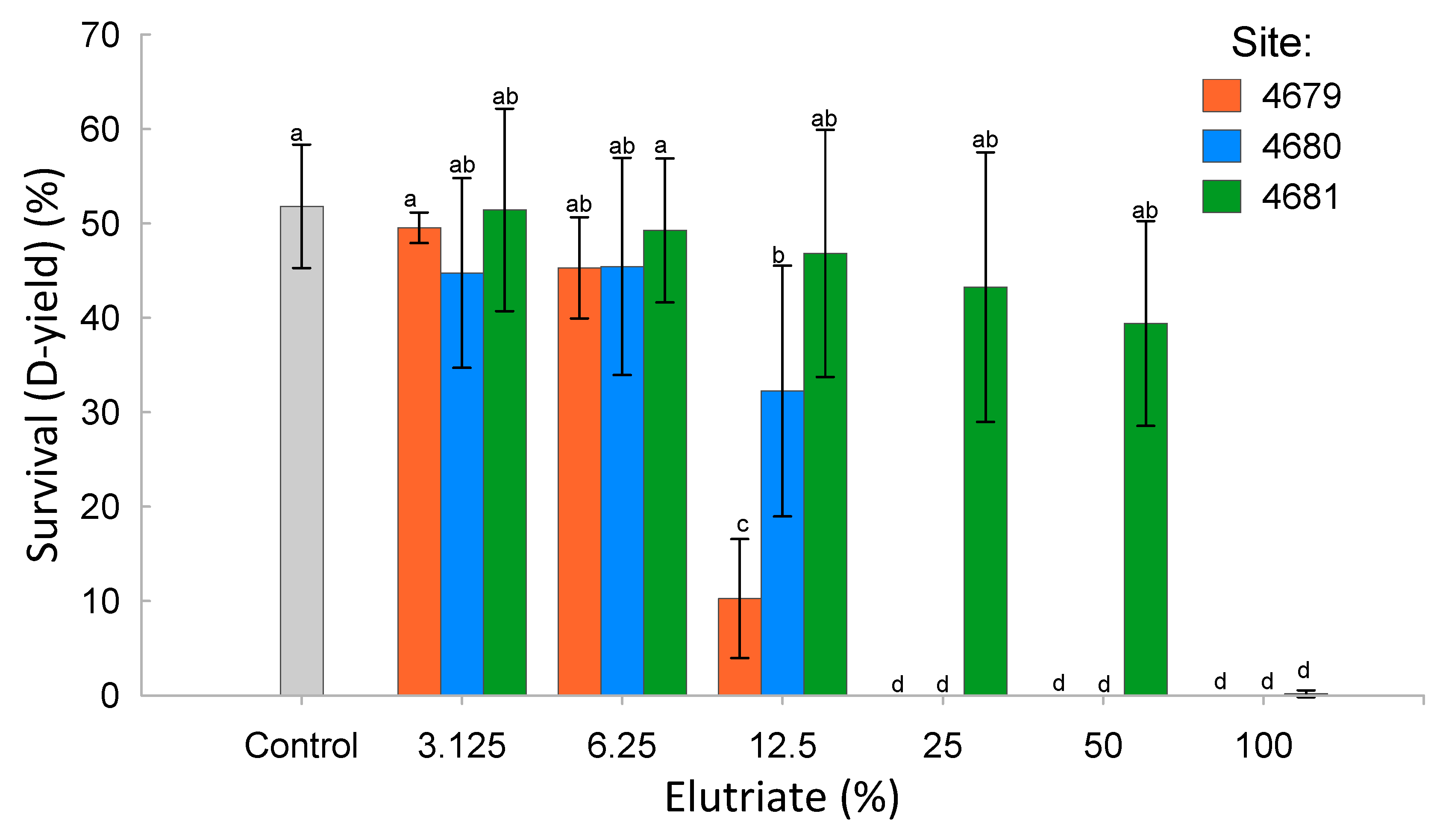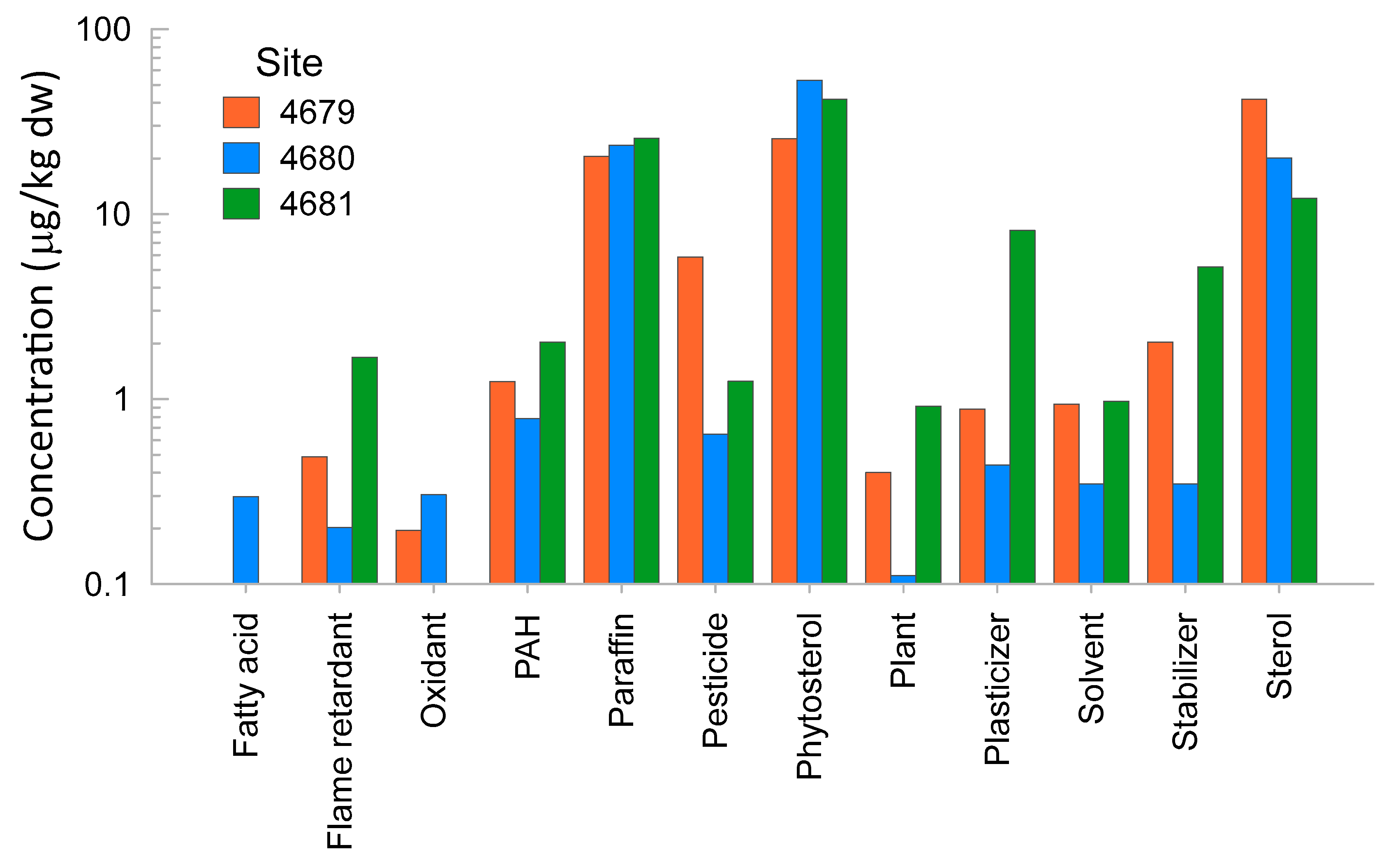Risk Assessment of Displaced Sediment by an Extreme Event Cyclone in a Peri-Urban Zone Using Bioassays and Analytical Chemistry
Abstract
1. Introduction
2. Materials and Methods
2.1. Reagents
2.2. Sample Collection and Pretreatment
- Waitangi Stream opposite 32 Waitangi Road (Site 4679) (latitude −39.54070, longitude 176.91752);
- Waitangi Stream D/S BioRich driveway (Site 4680) (latitude −39.55579, longitude 176.92030);
- Waitangi Stream D/S stopbank—receiving environment (Site 4681) (latitude 39.55939, longitude 176.92128).
2.3. Toxicity Testing
2.3.1. Elutriates and Sediment Extract Preparations
2.3.2. Bioassays
- In vitro yeast two-hybrid assay
- Microtox® (Aliivibrio fischeri) bioluminescence inhibition
- Blue mussel (Mytilus galloprovincialis) embryo–larval development/survival
2.4. Chemical Analysis
2.4.1. Rapid Comprehensive Chemical Analysis
2.4.2. Targeted Chemical Analysis
2.5. Statistical Analysis
3. Results
3.1. Bioassays
3.1.1. AhR and CAR
3.1.2. Microtox®
3.1.3. Blue Mussel Embryo–Larval Development Assay
3.2. Chemical Analysis
3.2.1. Rapid Comprehensive Chemical Analysis
3.2.2. Targeted Analysis
4. Discussion
5. Conclusions
Supplementary Materials
Author Contributions
Funding
Institutional Review Board Statement
Informed Consent Statement
Data Availability Statement
Acknowledgments
Conflicts of Interest
References
- Espinoza, V.; Waliser, D.E.; Guan, B.; Lavers, D.A.; Ralph, F.M. Global Analysis of Climate Change Projection Effects on Atmospheric Rivers. Geophys. Res. Lett. 2018, 45, 4299–4308. [Google Scholar] [CrossRef]
- Pohl, B.; Prince, H.D.; Wille, J.; Kingston, D.G.; Cullen, N.J.; Fauchereau, N. Atmospheric Rivers and Weather Types in Aotearoa New Zealand: A Two-Way Story. J. Geophys. Res. Atmos. 2023, 128, e2022JD037209. [Google Scholar] [CrossRef]
- Williams, J.; Behrens, E.; Morgenstern, O.; Gibson, P.; Teixeira, J. Coupled atmosphere-ocean simulations of contemporary and future South Pacific tropical cyclones. EGUsphere 2023, 2023, 1–31. [Google Scholar] [CrossRef]
- Council, N.C. Cyclone Gabrielle. Available online: https://www.napier.govt.nz/our-council/cyclone-gabrielle (accessed on 28 September 2023).
- Alderman, K.; Turner, L.R.; Tong, S.L. Floods and human health: A systematic review. Environ. Int. 2012, 47, 37–47. [Google Scholar] [CrossRef] [PubMed]
- Han, I.; Whitworth, K.W.; Christensen, B.; Afshar, M.; Han, H.A.; Rammah, A.; Oluwadairo, T.; Symanski, E. Heavy metal pollution of soils and risk assessment in Houston, Texas following Hurricane Harvey. Environ. Pollut. 2022, 296, 118717. [Google Scholar] [CrossRef] [PubMed]
- Fox, M.; Chari, R.; Resnick, B.; Burke, T. Potential for Chemical Mixture Exposures and Health Risks in New Orleans Post-Hurricane Katrina. Hum. Ecol. Risk Assess. 2009, 15, 831–845. [Google Scholar] [CrossRef]
- Mandigo, A.C.; DiScenza, D.J.; Keimowitz, A.R.; Fitzgerald, N. Chemical contamination of soils in the New York City area following Hurricane Sandy. Environ. Geochem. Health 2016, 38, 1115–1124. [Google Scholar] [CrossRef] [PubMed]
- Kamata, R.; Nakajima, D.; Shiraishi, F. Agonistic effects of diverse xenobiotics on the constitutive androstane receptor as detected in a recombinant yeast-cell assay. Toxicol. Vitr. 2018, 46, 335–349. [Google Scholar] [CrossRef] [PubMed]
- Shiraishi, F.; Kamata, R.; Terasaki, M.; Takigami, H.; Imaizumi, Y.; Yagishita, M.; Nakajima, D. Screening data for the endocrine disrupting activities of 583 chemicals using the yeast two-hybrid assay. Data Brief 2018, 21, 2543–2546. [Google Scholar] [CrossRef]
- Omagari, R.; Miyabara, Y.; Hashimoto, S.; Miyawaki, T.; Toyota, M.; Kadokami, K.; Nakajima, D. The rapid survey method of chemical contamination in floods caused by Typhoon Hagibis by combining in vitro bioassay and comprehensive analysis. Environ. Int. 2022, 159, 107017. [Google Scholar] [CrossRef]
- ASTM E1391-03; Standard Guide for Collection, Storage, Characterization, Manipulation of Sediments for Toxicological Testing and for Selection of Samplers Used to Collect Benthic Invertebrates. ASTM International: West Conshohocken, PA, USA, 2014.
- ASTM D2216; Standard Test Method for Laboratory Determination of Water (Moisture) Content of Soil and Rock by Mass. ASTM International: West Conshohocken, PA, USA, 1998.
- Shiraishi, F.; Shiraishi, H.; Nishikawa, J.; Nishihara, C.; Morita, M. Development of a simple estrogen assay system using the yeast Two-Hybrid System. Environ. Chem. 2000, 10, 57–64. [Google Scholar] [CrossRef]
- Johnson, B.T. Microtox® Acute Toxicity Test. In Small-Scale Freshwater Toxicity Investigations: Toxicity Test Methods; Blaise, C., Férard, J.-F., Eds.; Springer: Dordrecht, The Netherlands, 2005; pp. 69–105. [Google Scholar]
- ISO 11348-3; Water Quality—Determination of the Inhibitory Effect of Water Samples on the Light Emission of Vibrio fischeri (Luminescent Bacteria Test)—Part 3: Method Using Freeze-Dried Bacteria. International Organization for Standardization: Geneva, Switzerland, 1999.
- ASTM E724-21; Standard Guide for Conducting Static Short-Term Chronic Toxicity Tests Starting with Embryos of Four Species of Saltwater Bivalve Molluscs. ASTM International: West Conshohocken, PA, USA, 2021. [CrossRef]
- Omagari, R.; Nakayama, T.; Miyawaki, T.; Yagishita, M.; Hashimoto, S.; Kadokami, K.; Nakajima, D. Evaluation of identification accuracy using AIQS for GC-MS for measuring heavily contaminated samples. Chemosphere 2021, 285, 131401. [Google Scholar] [CrossRef] [PubMed]
- ANZ. Australian & New Zeleand Guidelines for Fresh and Marine Water Quality—Toxicant Default Guidelines Values for Sediment Quality. Available online: https://www.waterquality.gov.au/anz-guidelines/guideline-values/default/sediment-quality-toxicants (accessed on 24 July 2023).
- R Core Team. R: A Language and Environment for Statistical Computing; R Foundation for Statistical Computing: Vienna, Austria, 2023. [Google Scholar]
- Ritz, C.; Baty, F.; Streibig, J.C.; Gerhard, D. Dose-response analysis using R. PLoS ONE 2015, 10, e0146021. [Google Scholar] [CrossRef]
- Fisher, R.; Barneche, D.; Ricardo, G.; Fox, D. A Bayesian No-Effect-Concentration (NEC) Algorithm. R package version 2.1.0.3. 2024. Available online: https://open-aims.github.io/bayesnec/ (accessed on 2 July 2024).
- SCHEER. Scientific Committee on Health, Environmental and Emerging Risks (SCHEER). Available online: https://health.ec.europa.eu/scientific-committees/scientific-committee-health-environmental-and-emerging-risks-scheer_en (accessed on 14 January 2024).
- Crawford, S.E.; Brinkmann, M.; Ouellet, J.D.; Lehmkuhl, F.; Reicherter, K.; Schwarzbauer, J.; Bellanova, P.; Letmathe, P.; Blank, L.M.; Weber, R.; et al. Remobilization of pollutants during extreme flood events poses severe risks to human and environmental health. J. Hazard. Mater. 2022, 421, 126691. [Google Scholar] [CrossRef] [PubMed]
- Cerro-Gálvez, E.; Sala, M.M.; Marrasé, C.; Gasol, J.M.; Dachs, J.; Vila-Costa, M. Modulation of microbial growth and enzymatic activities in the marine environment due to exposure to organic contaminants of emerging concern and hydrocarbons. Sci. Total Environ. 2019, 678, 486–498. [Google Scholar] [CrossRef] [PubMed]
- Vila-Costa, M.; Sebastián, M.; Pizarro, M.; Cerro-Gálvez, E.; Lundin, D.; Gasol, J.M.; Dachs, J. Microbial consumption of organophosphate esters in seawater under phosphorus limited conditions. Sci. Rep. 2019, 9, 233. [Google Scholar] [CrossRef] [PubMed]
- Keita, D.; Shishodia, S.; Sridhar, B.B.M. Cytotoxicity analysis of pre- and post-hurricane harvey soil samples collected from greater houston bayous. Ecotoxicol. Environ. Saf. 2021, 223, 112600. [Google Scholar] [CrossRef] [PubMed]
- Beiras, R.; Fernández, N.; Bellas, J.; Besada, V.; González-Quijano, A.; Nunes, T. Integrative assessment of marine pollution in Galician estuaries using sediment chemistry, mussel bioaccumulation, and embryo-larval toxicity bioassays. Chemosphere 2003, 52, 1209–1224. [Google Scholar] [CrossRef]
- Leusch, F.D.L.; Allen, H.; De Silva, N.A.L.; Hodson, R.; Johnson, M.; Neale, P.A.; Stewart, M.; Tremblay, L.A.; Wilde, T.; Northcott, G.L. Effect-based monitoring of two rivers under urban and agricultural influence reveals a range of biological activities in sediment and water extracts. J. Environ. Manag. 2024, 351, 119692. [Google Scholar] [CrossRef]
- Boul, H.L.; Garnham, M.L.; Hucker, D.; Baird, D.; Aislabie, J. Influence of agricultural practices on the levels of DDT and its residues in soil. Environ. Sci. Technol. 1994, 28, 1397–1402. [Google Scholar] [CrossRef]
- Boul, H.L. DDT residues in the environment—A review with a New Zealand perspective. N. Z. J. Agric. Res. 1995, 38, 257–277. [Google Scholar] [CrossRef]
- Corona-Cruz, A.; Gold-Bouchot, G.; Gutierrez-Rojas, M.; Monroy-Hermosillo, O.; Favela, E. Anaerobic–aerobic biodegradation of DDT (dichlorodiphenyl trichloroethane) in soils. Bull. Environ. Contam. Toxicol. 1999, 63, 219–225. [Google Scholar] [CrossRef] [PubMed]
- Cutright, T.J.; Erdem, Z. Overview of the bioremediation and the degradation pathways of DDT. Adnan Menderes Üniversitesi Ziraat Fakültesi Derg. 2012, 9, 39–45. [Google Scholar]
- Yang, Y.; Wu, N.X.; Wang, C.L. Toxicity of the pyrethroid bifenthrin insecticide. Environ. Chem. Lett. 2018, 16, 1377–1391. [Google Scholar] [CrossRef]
- Mukherjee, I.; Singh, R.; Govil, J.N. Risk assessment of a synthetic pyrethroid, bifenthrin on pulses. Bull. Environ. Contam. Toxicol. 2010, 84, 294–300. [Google Scholar] [CrossRef] [PubMed]
- Islam, M.S.; Nakagawa, K.; Yu, Z.-Q.; Takao, Y.; Berndtsson, R. Coprostanol adsorption behavior in agricultural soil, riverbed sediment, and sand. J. Environ. Chem. Eng. 2023, 11, 110029. [Google Scholar] [CrossRef]
- Isobe, K.O.; Tarao, M.; Zakaria, M.P.; Chiem, N.H.; Minh, L.Y.; Takada, H. Quantitative application of fecal sterols using gas chromatography-mass spectrometry to investigate fecal pollution in tropical waters: Western Malaysia and Mekong Delta, Vietnam. Environ. Sci. Technol. 2002, 36, 4497–4507. [Google Scholar] [CrossRef]
- Leeming, R.; Ball, A.; Ashbolt, N.; Nichols, P. Using faecal sterols from humans and animals to distinguish faecal pollution in receiving waters. Water Res. 1996, 30, 2893–2900. [Google Scholar] [CrossRef]
- Prost, K.; Birk, J.J.; Lehndorff, E.; Gerlach, R.; Amelung, W. Steroid biomarkers revisited—Improved source identification of faecal remains in archaeological soil material. PLoS ONE 2017, 12, e0164882. [Google Scholar] [CrossRef]
- Lea, L.J.; Hepburn, P.A.; Wolfreys, A.M.; Baldrick, P. Safety evaluation of phytosterol esters. Part 8. Lack of genotoxicity and subchronic toxicity with phytosterol oxides. Food Chem. Toxicol. 2004, 42, 771–783. [Google Scholar] [CrossRef]
- Maffei, M.; Badino, S.; Bossi, S. Chemotaxonomic significance of leaf wax n-alkanes in the Pinales (Coniferales). J. Biol. Res. 2004, 1, 3–19. [Google Scholar]
- Morrison, R.T.; Boyd, R.K. Organic Chemistry, 6th ed.; Prentice Hall: Reading, MA, USA, 1992; p. 1278. [Google Scholar]
- Cressey, P.; Russell, K. Health Risk Assessment: Supporting Community Recovery from Cyclone Gabrielle—Contamination Resulting from Flooding Events; ESR: Christchurch, New Zealand, 2024; p. 51. [Google Scholar]
- Harmon, S.M.; Wyatt, D.E. Evaluation of post-Katrina flooded soils for contaminants and toxicity to the soil invertebrates Eisenia fetida and Caenorhabditis elegans. Chemosphere 2008, 70, 1857–1864. [Google Scholar] [CrossRef] [PubMed]




| Score | RI | MS Hit Rate (%) | QT Ratio |
|---|---|---|---|
| ***** | −10 to +10 | >25 | Not considered |
| **** | −20 to +20 | >25 | Not considered |
| *** | −10 to +10 | <25 | 0.9 to 1.1 |
| ** | −20 to +20 | <25 | 0.8 to 1.2 |
| * | −20 to +20 | <25 | <0.8 or >1.2 |
| Site | AhR (µg-βna eq./kg-dw) | CAR (µg-4 op eq./kg-dw) |
|---|---|---|
| 4679 | 427 | 140 |
| 4680 | 349 | 34 |
| 4681 | 502 | 145 |
| Site | LC10 (%) (95%CI) | LC25 (%) (95%CI) | LC50 (%) (95%CI) | N(S)EC (%) (95%CI) | NOEC | LOEC |
|---|---|---|---|---|---|---|
| 4679 | 5.5 (4.4–6.6) | 7.5 (6.5–8.4) | 9.7 (9.0–10.4) | 10.7 (7.9–12.2) | 6.25 | 12.5 |
| 4680 | 9.6 (8.6–10.7) | 11.9 (11.3–12.6) | 14.4 (13.7–15.2) | 12.3 (11.4–22.4) | 6.25 | 12.5 |
| 4681 | 42.6 (38.3–47.0) | 53.0 (49.1–56.9) | 64.1 (60.5–67.7) | 58.9 (46.2–95.7) | 50 | 100 |
| Metal/Metalloid | Site 4679 | Site 4680 | Site 4681 | DGV | DGV High |
|---|---|---|---|---|---|
| Arsenic | 6.3 | 6.8 | 8.8 | 20 | 70 |
| Cadmium | 0.127 | 0.187 | 1.09 | 1.5 | 10 |
| Chromium | 21 | 20 | 22 | 80 | 370 |
| Copper | 10.4 | 8.7 | 15.9 | 65 | 270 |
| Lead | 13 | 13.3 | 12.4 | 50 | 220 |
| Mercury | 0.07 | 0.07 | 0.1 | 0.15 | 1 |
| Nickel | 14.7 | 15.4 | 14.2 | 21 | 52 |
| Zinc | 149 | 70 | 128 | 200 | 410 |
| Site 4679 | Site 4680 | Site 4681 | DGV | DGV High | ||||
|---|---|---|---|---|---|---|---|---|
| Meas. | Norm. | Meas. | Norm. | Meas. | Norm. | |||
| Bifenthrin | 33 | 18.1 | <6 | 6 | 2.5 | 0.11 | ||
| 2,4′-DDD | <1 | 22 | 15.2 | 28 | 11.7 | |||
| 4,4′-DDD | 4.4 | 2.4 | 12.9 | 8.9 | 111 | 46.3 | ||
| 2,4′- + 4,4′-DDD | 4.4 | 2.4 | 34.9 | 24.1 | 139 | 57.9 | 3.5 | 9 |
| 4,4′-DDE | 4.2 | 2.3 | 25 | 17.2 | 20 | 8.3 | 1.4 | 7 |
| 2,4’-DDT | <1 | – | 1.6 | 1.1 | <1 | – | ||
| 4,4’-DDT | 2.7 | 1.5 | 14.8 | 10.2 | 6.9 | 2.9 | ||
| Total DDT | 2.7 | 1.5 | 16.4 | 11.3 | 6.9 | 2.9 | 1.2 | 5 |
| Total DDT Isomers | 12 | 6.6 | 56 | 38.6 | 230 | 95.8 | ||
| Dieldrin | <1 | – | 1.3 | 0.9 | <1 | – | 2.8 | 7 |
Disclaimer/Publisher’s Note: The statements, opinions and data contained in all publications are solely those of the individual author(s) and contributor(s) and not of MDPI and/or the editor(s). MDPI and/or the editor(s) disclaim responsibility for any injury to people or property resulting from any ideas, methods, instructions or products referred to in the content. |
© 2024 by the authors. Licensee MDPI, Basel, Switzerland. This article is an open access article distributed under the terms and conditions of the Creative Commons Attribution (CC BY) license (https://creativecommons.org/licenses/by/4.0/).
Share and Cite
Tremblay, L.A.; Nakajima, D.; Endo, S.; Yagishita, M.; Ludlow, H.; Mackay, A.; Champeau, O. Risk Assessment of Displaced Sediment by an Extreme Event Cyclone in a Peri-Urban Zone Using Bioassays and Analytical Chemistry. Toxics 2024, 12, 558. https://doi.org/10.3390/toxics12080558
Tremblay LA, Nakajima D, Endo S, Yagishita M, Ludlow H, Mackay A, Champeau O. Risk Assessment of Displaced Sediment by an Extreme Event Cyclone in a Peri-Urban Zone Using Bioassays and Analytical Chemistry. Toxics. 2024; 12(8):558. https://doi.org/10.3390/toxics12080558
Chicago/Turabian StyleTremblay, Louis A., Daisuke Nakajima, Satoshi Endo, Mayuko Yagishita, Hannah Ludlow, Ariana Mackay, and Olivier Champeau. 2024. "Risk Assessment of Displaced Sediment by an Extreme Event Cyclone in a Peri-Urban Zone Using Bioassays and Analytical Chemistry" Toxics 12, no. 8: 558. https://doi.org/10.3390/toxics12080558
APA StyleTremblay, L. A., Nakajima, D., Endo, S., Yagishita, M., Ludlow, H., Mackay, A., & Champeau, O. (2024). Risk Assessment of Displaced Sediment by an Extreme Event Cyclone in a Peri-Urban Zone Using Bioassays and Analytical Chemistry. Toxics, 12(8), 558. https://doi.org/10.3390/toxics12080558








